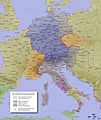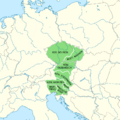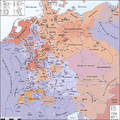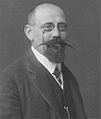History of Austria facts for kids
The history of Austria is a long and exciting story about a country in the heart of Europe. For thousands of years, different groups of people have lived here, shaping the land and its culture. From ancient Celtic kingdoms to a powerful empire and then a modern republic, Austria has seen many changes.
The name Ostarrîchi, which means "Eastern Realm," was first used in 996 AD. This was when Austria was a small border area of the Duchy of Bavaria. Later, it became an independent duchy and then an archduchy within the Holy Roman Empire.
For over 600 years, from 1273 to 1918, Austria was mostly ruled by the powerful House of Habsburg family. In 1806, the Holy Roman Empire ended, and Austria became the Austrian Empire. After World War I in 1918, this large empire broke apart. Austria became a smaller, German-speaking country called the First Austrian Republic.
In 1938, Adolf Hitler annexed Austria into Nazi Germany. This was called the Anschluss. After World War II, Austria became independent again in 1955 as the Second Austrian Republic. In 1995, Austria joined the European Union.
Contents
- Austria's Early Beginnings
- Austria in the Middle Ages
- Austria Becomes a Great Power (1453–1564)
- Austria and the Thirty Years' War (1618–1648)
- Austria Becomes a Major European Power (1648–1740)
- Maria Theresa and Reforms (1740–1780)
- The Age of Enlightenment: Joseph II and Leopold II (1780–1792)
- Austria and the Napoleonic Wars (1792–1815)
- The 19th Century: Change and Conflict (1815–1914)
- Austria in World War I (1914–1918)
- The First Austrian Republic (1918–1933)
- Dictatorship and Annexation (1933–1945)
- The Second Austrian Republic (since 1945)
- Images for kids
- See also
Austria's Early Beginnings
Ancient Times: From Stone Age to Celts
People have lived in what is now Austria since the early Stone Age. The oldest signs of humans are over 250,000 years old. Later, in the late Iron Age around 800 BC, the Hallstatt Celts lived here. They formed a Celtic kingdom called Noricum.
Around 40 AD, the southern parts of Austria became part of the Roman Empire. Important Roman towns included Carnuntum, Vindobona (Vienna), and Juvavum (Salzburg). Christianity also arrived in Austria during Roman times.
The Migration Period and New Peoples
After the Roman Empire weakened, different groups moved into Austria. In the 6th century, the Bavarii, a Germanic people, settled in the western parts. In the east, Slavic peoples formed the kingdom of Carantania. These groups mixed with the people already living there. Over time, the Bavarian language (which became German) spread across most of Austria.
Austria in the Middle Ages
The Rise of the Babenbergs (976–1246)
Around 800 AD, Charlemagne created a border area called the Avar March in eastern Austria to protect against invaders. In 976, the Babenberg family took control of this "Eastern March," or Ostarrîchi. This is the first time the name Austria was used in a document in 996 AD.
The Babenbergs worked to settle the land, building towns and monasteries. In 1156, Emperor Frederick Barbarossa made Austria an independent duchy. This was a big step for Austria. The Babenbergs became very powerful. They even gained control of Styria in 1192.
However, the Babenberg family ended in 1246 when Frederick II died without children.
A Time of Change: The Interregnum (1246–1278)
After the Babenbergs, there was a period called the interregnum, where different rulers tried to control Austria. Ottokar II, the King of Bohemia, took over most of the area. He was a strong ruler who founded the Hofburg Palace in Vienna.
During this time, there was also persecution of people who were seen as heretics.
The Habsburgs Take Over (1278–1453)
In 1273, Rudolf I of Habsburg became the new Holy Roman Emperor. He challenged Ottokar II and defeated him in the Battle on the Marchfeld in 1278. This victory brought Austria under the rule of the House of Habsburg. This family would rule Austria for over 600 years!
The Habsburgs slowly gained more lands. In 1335, they acquired Carinthia and Carniola. In 1363, they added Tyrol.
Rudolf IV (1358–1365) was an important early Habsburg ruler. He claimed the title of Archduke for Austria, which made it seem more important. He also founded the University of Vienna and built St. Stephen's Cathedral.
However, the Habsburg lands were often divided among family members, leading to conflicts. This weakened Austria for a while.
Austria Becomes a Great Power (1453–1564)
The Archduchy of Austria: Growing Stronger
In 1453, Emperor Frederick III officially made Austria an archduchy. This gave Austria a higher status in the Holy Roman Empire. Frederick was very good at using marriages to expand the Habsburg lands. His son, Maximilian I, married Mary of Burgundy, which brought the rich Low Countries (modern-day Belgium and Netherlands) into the family.
This led to the famous saying about the Habsburgs: "Bella gerant alii, tu felix Austria nube" (Let others wage war, you, fortunate Austria, marry). This meant that while other countries fought, Austria gained power through clever marriages.
Maximilian I (1493–1519) reunited all the Austrian lands. His grandson, Charles I, inherited a massive empire that included Spain, its colonies, and parts of Italy. He was the most powerful Habsburg ruler.
The Reformation and the Ottoman Threat
During this time, the Reformation began with Martin Luther in 1517. This led to a split in Christianity between Catholics and Protestants. Austria, under Ferdinand I, remained Catholic, but many other parts of the empire became Protestant.
Austria also faced a new threat from the east: the Ottoman Empire. The Ottomans invaded Hungary and even laid siege to Vienna in 1529. The Habsburgs fought many wars against the Ottomans for over 200 years.
Austria and the Thirty Years' War (1618–1648)
Religious Conflicts and War
The 16th century saw the start of the Counter-Reformation, where the Catholic Church tried to win back followers. This led to strong religious tensions. Ferdinand II (1619–1637) was a very strict Catholic. His efforts to make everyone Catholic in his lands helped start the Thirty Years' War in 1618.
This war was devastating for Central Europe. It was a struggle for power and religion. Although the Habsburgs faced many challenges, they managed to keep control of their main territories. The war ended in 1648 with the Peace of Westphalia. This peace weakened the Holy Roman Empire but strengthened the Habsburgs' power within their own lands.
Austria Becomes a Major European Power (1648–1740)
Leopold I and Victory Over the Ottomans
After the Thirty Years' War, Austria recovered and grew stronger. Leopold I (1657–1705) reunited all the Austrian lands in 1665. His long reign was marked by important wars.
In 1683, the Ottomans again laid siege to Vienna. But this time, an allied army, including Polish forces, defeated them. This was a major turning point. Austria then pushed the Ottomans back, gaining much territory in the Great Turkish War (1683–1699). This made Austria a dominant power in Central Europe.
The War of the Spanish Succession
Austria also fought in the War of the Spanish Succession (1701–1714). This war was about who would inherit the vast Spanish Habsburg territories. Although France gained control of Spain, Austria made significant gains in Western Europe, including parts of modern-day Belgium and Italy. By 1714, Austria was a key player in European politics.
Charles VI and the Pragmatic Sanction
Charles VI (1711–1740) faced a problem: he had no sons, only daughters. To ensure his daughter, Maria Theresa, could inherit all his lands, he issued the Pragmatic Sanction of 1713. This document stated that the Habsburg lands could be passed down through a female heir and could not be divided. He spent years trying to get other European countries to agree to this.
Maria Theresa and Reforms (1740–1780)
War of Austrian Succession
When Charles VI died in 1740, many countries ignored the Pragmatic Sanction. Frederick the Great of Prussia invaded Silesia, a rich Austrian province. This started the War of the Austrian Succession (1740–1748). Maria Theresa fought bravely to keep her lands. She lost Silesia to Prussia, but she managed to hold onto most of her empire.
Her husband, Francis of Lorraine, became the Holy Roman Emperor, starting the new House of Habsburg-Lorraine dynasty.
Reforms and Modernization
Maria Theresa was a strong and intelligent ruler. She realized Austria needed to modernize to compete with other European powers. She introduced many important reforms:
- Financial Reforms: She taxed the nobility for the first time and improved state finances.
- Government Reforms: She centralized the government, creating a more efficient civil service.
- Education Reforms: She reformed the University of Vienna and made elementary education compulsory for all children from ages 6 to 12. This was a big step towards widespread education.
- Civil Rights: She abolished torture and witch burning.
Maria Theresa was a devout Catholic, but she also reduced the power of the Church in state affairs. She ruled with her son, Joseph II, who became emperor in 1765.
The Age of Enlightenment: Joseph II and Leopold II (1780–1792)
Joseph II: The "Enlightened Despot"
Joseph II (1780–1790) was a true believer in the Enlightenment. He wanted to modernize Austria very quickly. He issued thousands of new laws to change almost every part of the empire. His policies were called "Josephinism."
Some of his key reforms included:
- Religious Tolerance: He introduced a policy of religious tolerance, allowing more freedom for Protestants and Jews.
- Church Reforms: He reduced the power of the Catholic Church, closing many monasteries and making the clergy more accountable to the state.
- Legal Reforms: He abolished brutal punishments and the death penalty in most cases.
- Language: He made German the official language throughout the empire to promote unity.
Joseph's reforms were often met with resistance from the nobility and even common people because they changed too much too fast. He also engaged in wars to expand his territory, which were often costly.
Leopold II: A Brief Reign
Joseph II's brother, Leopold II (1790–1792), succeeded him. Leopold was more cautious and tried to calm the unrest caused by Joseph's rapid changes. He also faced the growing threat of the French Revolution. He died shortly after taking the throne.
Austria and the Napoleonic Wars (1792–1815)
Francis II and the French Threat
Francis II (1792–1835) became emperor during a time of great upheaval. The French Revolution and the rise of Napoleon Bonaparte changed Europe forever. Austria fought several wars against France, known as the French Revolutionary Wars and Napoleonic Wars.
Austria lost many battles and territories to Napoleon. In 1804, Francis II declared himself "Emperor of Austria" as Francis I, because he saw the old Holy Roman Empire coming to an end. In 1806, Napoleon forced Francis to dissolve the Holy Roman Empire completely.
The Congress of Vienna
After Napoleon's final defeat in 1815, European leaders gathered at the Congress of Vienna. Austria, led by its clever foreign minister Metternich, played a major role. The Congress redrew the map of Europe and tried to restore peace and stability. Austria gained some territories back and became the leader of the new German Confederation.
The 19th Century: Change and Conflict (1815–1914)
The Age of Metternich (1815–1848)
After the Congress of Vienna, Austria entered a period of political stability, but also strict censorship and a strong police state under Metternich. This era is also known for its culture, called "Biedermeier."
However, ideas of liberalism (more freedom for individuals) and nationalism (people wanting their own independent nations) were growing across Europe.
The Revolutions of 1848
These ideas led to the Revolutions of 1848 across Europe, including Austria. Metternich was forced to resign, and Emperor Ferdinand I stepped down. His young nephew, Franz Joseph, became the new emperor. One important change from the revolution was the freeing of peasants, which helped with industrialization.
Franz Joseph I and the Dual Monarchy (1848–1914)
Franz Joseph I (1848–1916) ruled for a very long time. Austria faced more challenges, especially from Italy and Prussia.
- Italian Unification: Austria lost its territories in northern Italy after wars in 1859.
- Austro-Prussian War (1866): Austria fought a war against Prussia for leadership among the German states. Austria lost, and Prussia became the dominant power in Germany. Austria was now excluded from German affairs.
These defeats forced Franz Joseph to make a major change. In 1867, Austria formed a "Dual Monarchy" with Hungary, called Austria-Hungary. This meant Hungary gained more independence, but they shared a common ruler (Franz Joseph was King of Hungary and Emperor of Austria) and common foreign and military policies.
The late 19th century was a time of growth and modernization for Austria, especially Vienna. New buildings were constructed, and industries developed. However, nationalist tensions among the many different ethnic groups within Austria-Hungary continued to grow.
Austria in World War I (1914–1918)
Nationalist tensions finally exploded in 1914. The assassination of Archduke Franz Ferdinand, the heir to Franz Joseph, in Sarajevo triggered World War I. Austria-Hungary, allied with Germany, fought against the Allied Powers.
In 1916, Emperor Franz Joseph died, and Charles (Karl) became the new emperor. The war was long and devastating. In 1918, the Central Powers were defeated. This led to the collapse of the Austria-Hungarian Empire. Emperor Charles went into exile.
The First Austrian Republic (1918–1933)
A New Republic is Born
After World War I, the large Austria-Hungarian Empire was dissolved. On November 12, 1918, the Republic of German-Austria was proclaimed. Karl Renner became the first Chancellor. The new country was much smaller, mostly German-speaking, and faced many challenges. Many people thought it wouldn't survive on its own.
The Treaty of Saint-Germain
In 1919, the Treaty of Saint-Germain was signed. The Allied powers did not allow Austria to unite with Germany, fearing a powerful "Greater Germany." Austria was forced to change its name to the "Republic of Austria" (the First Austrian Republic). It also lost some German-speaking territories to Czechoslovakia and Italy. However, it gained a new region called Burgenland from Hungary.
The 1920s were a time of political conflict between the left-wing Social Democrats and the right-wing Christian Social Party. There were also violent clashes between different political groups.
Dictatorship and Annexation (1933–1945)
Austrofascism and Dollfuss
In 1932, Engelbert Dollfuß became Chancellor. He was concerned about the rise of Adolf Hitler and the Nazi Party in Germany. In 1933, Dollfuss dissolved parliament and established an authoritarian government, known as Austrofascism. He banned all other political parties, including the Nazis and Social Democrats. He wanted Austria to remain independent from Nazi Germany.
However, Dollfuss was assassinated by Austrian Nazis in July 1934.
Schuschnigg and the Anschluss
Kurt Schuschnigg became the new Chancellor. He tried to keep Austria independent, but Hitler put increasing pressure on Austria. In March 1938, Hitler demanded that Austria allow Nazis into its government. Schuschnigg resigned, and German troops entered Austria.
This was called the Anschluss, and Austria was annexed into Nazi Germany. Austria ceased to exist as an independent country. Many Austrians supported the Nazi regime, and some participated in its crimes. Those who opposed the Nazis, like Jews and Communists, were persecuted.
In March 1945, near the end of World War II, Allied forces entered Austria.
The Second Austrian Republic (since 1945)
Allied Occupation
After World War II, Austria was occupied by the Allied powers (American, British, French, and Soviet forces). Vienna was also divided into four zones. However, Austria was treated more as a liberated country than a defeated one. Karl Renner again formed a government that included different political groups.
Austria received aid from the Marshall Plan to rebuild its economy. Unlike the First Republic, the Second Republic became a stable democracy. The two largest parties, the Austrian People's Party (ÖVP) and the Social Democratic Party (SPÖ), often formed coalitions.
Independence and Neutrality
The Allied occupation ended in 1955 when the Austrian State Treaty was signed. Austria was declared a neutral country, meaning it would not join any military alliances. This neutrality was written into its constitution.
The political system was characterized by "Proporz", where important government positions were shared between the two main parties. This helped ensure stability and consensus in decision-making.
Recent Years
In 1995, Austria joined the European Union. In recent decades, Austrian politics have seen shifts in coalitions and the rise of new parties. The country continues to be a stable and prosperous democracy in the heart of Europe.
Images for kids
-
The province of Noricum highlighted within the Roman Empire.
-
Routes of Babarian invasions, 100–500 AD.
-
The Holy Roman Empire in the 10th century showing Bavarian marches, including Carinthia.
-
The Duchy of Bavaria (Bajovaria), Margravate of Ostarrichi and the Duchy of Carantania c. 1000 AD.
-
The realms of Ottokar II.
-
Rudolf of Habsburg, Speyer cathedral where he was buried.
-
Frederick V (1415–1493) by Hans Burgkmair, c. 1500 (Kunsthistorisches Museum, Vienna). Duke 1424, King 1440, Emperor 1452, Archduke 1457.
-
1997 Monument to those burned by Petrus Zwicker in Steyr in 1397.
-
Maximilian I by Albrecht Dürer 1519
-
Charles I, attrib. Lambert Sustris 1548, Museo del Prado, Madrid, Spain
-
Much of eastern Austria adopted Lutheranism until counterreformational efforts changed it in the late 16th century.
-
The Crown of Emperor Rudolf II.
-
Archduke Ferdinand II 1619–1637, architect of Counter-Reformation
-
Leopold I, 1657–1705.
-
The Battle of Vienna, 1683.
-
Maria Theresa of Austria as a young woman in 1727.
-
Joseph II (right) with his brother and successor Leopold VII (left)
-
Victorious Archduke Charles of Austria during the Battle of Aspern-Essling (21–22 May 1809)
-
Prince Metternich, by Thomas Lawrence c. 1820
-
Empress Elisabeth, known as "Sisi"
-
Small coat of arms of the Austro-Hungarian Empire 1867–1915, with the Habsburg Order of the Golden Fleece superimposed on the Austrian Doubleheaded Eagle, and crested by the Crown of Rudolf II
-
The Secession Building, Vienna, built in 1897 by Joseph Maria Olbrich for exhibitions of the Secession group
-
Austro-Hungarian prisoners of war in Russia, 1915
-
Karl Renner in 1905, Chancellor 12 November 1918 – 7 July 1920, President of the National Council 1931–1933
-
Kurt Waldheim, Secretary General of United Nations. He became a president of Austria (1986–92).
See also
 In Spanish: Historia de Austria para niños
In Spanish: Historia de Austria para niños
Articles
Austria
- Archduchy of Austria
- Austria-Hungary
- Austria under National Socialism
- Austrian Empire
- Duchy of Austria
- Elections in Austria
- Habsburg monarchy
- History of Vienna
- Name of Austria
- Politics of Austria
- Timeline of Austrian history
Other
Lists
- List of famous Austrians
- List of German monarchs
- List of rulers of Austria
- List of Austrian consorts
- List of Holy Roman emperors
- List of Holy Roman empresses
- List of chancellors of Austria
- List of presidents of Austria
- List of ministers-president of Austria
- List of foreign ministers of Austria-Hungary
- List of political parties in Austria














































